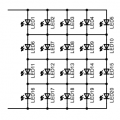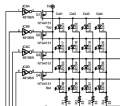First photo is the intended goal.
Second photo is how I soldered it together
Third is my fake schematic (dont know how to read/write schematics)
final photo is schematic from tinkercad (not sure if its accurate)
I want to make something for myself that looks like the first photo. Potentially using thousands of LEDs, and hope to figure out if my wiring makes sense, and if I can power with a single source, and how to calculate power requirements. I havent seen anyone wiring up LEDs this way, so not sure if there is an inherent flaw in my design to begin with.
Any help will be greatly appreciated.
Second photo is how I soldered it together
Third is my fake schematic (dont know how to read/write schematics)
final photo is schematic from tinkercad (not sure if its accurate)
I want to make something for myself that looks like the first photo. Potentially using thousands of LEDs, and hope to figure out if my wiring makes sense, and if I can power with a single source, and how to calculate power requirements. I havent seen anyone wiring up LEDs this way, so not sure if there is an inherent flaw in my design to begin with.
Any help will be greatly appreciated.
Attachments
-
313.9 KB Views: 23
-
1.4 MB Views: 23
-
1.5 MB Views: 22
-
151 KB Views: 22













